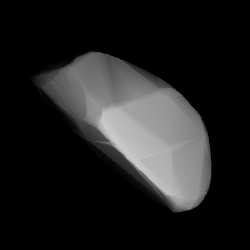 Shape model of Thomsen from its lightcurve | |
| Discovery [1] | |
|---|---|
| Discovered by | L. Oterma |
| Discovery site | Turku Obs. |
| Discovery date | 8 September 1942 |
| Designations | |
| (2064) Thomsen | |
Named after | Ivan Leslie Thomsen (New Zealand astronomer) [2] |
| 1942 RQ ·1958 RO 1974 OK ·1977 FE3 1977 KA ·A913 QB | |
| Mars-crosser [1] [3] | |
| Orbital characteristics [1] | |
| Epoch 4 September 2017 (JD 2458000.5) | |
| Uncertainty parameter 0 | |
| Observation arc | 74.50 yr (27,211 days) |
| Aphelion | 2.8967 AU |
| Perihelion | 1.4600 AU |
| 2.1783 AU | |
| Eccentricity | 0.3298 |
| 3.22 yr (1,174 days) | |
| 142.30° | |
| 0° 18m 23.76s / day | |
| Inclination | 5.6946° |
| 302.16° | |
| 2.7479° | |
| Earth MOID | 0.4446 AU |
| Physical characteristics | |
| 8.09±0.12 km [4] 13.59 km (derived) [5] 13.61±1.6 km (IRAS:2) [6] | |
| 4.2267±0.0001 h [7] 4.233 h [8] 4.244023±0.000001 h [9] 4.253±0.005 h [10] | |
| 0.0549±0.015(IRAS:2) [6] 0.0644 (derived) [5] 0.162±0.006 [4] | |
| SMASS = S [1] · S [5] [11] [12] B–V = 0.887 [1] U–B = 0.524 [1] | |
| 12.6 [1] ·12.93 [5] [8] ·13.10 [4] [6] [12] ·13.44±0.31 [11] | |
2064 Thomsen (prov. designation: 1942 RQ) is a stony asteroid and Mars-crosser on an eccentric orbit, that measures approximately 13 kilometers (8.1 miles) in diameter. The asteroid was discovered by Finnish astronomer Liisi Oterma at Turku Observatory, Finland, on 8 September 1942. [3] It was named after New Zealand astronomer Ivan Leslie Thomsen